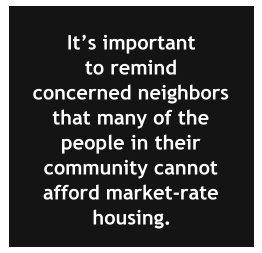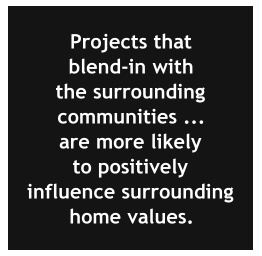Our Summer 2011 issue features an article by Rebecca Cohen and Keith Wardrip, analysts at the Center for Housing Policy in Washington, D.C. Titled, “The Economic & Fiscal Benefits of Affordable Housing,” Cohen and Wardrip report on why affordable housing is not the economic bane that many think it is.
As we usually do before we publish articles in the PCJ, we make a draft available for review. We received quite a few comments about Cohen and Wardrip’s article, some of which (given space limitations) are only briefly addressed in the article. I asked the authors if they’d take the time to respond to several of the comments that came in.
Dealing With the Fear of Affordable Housing
PCJ Editor Wayne Senville:
In one of the comments that came in, one person noted that: “Over the years, in my experience, most problems have arisen not with the affordable housing tools available to jurisdictions, but with the public living in proximity to proposed developments, especially larger-scale ones.” The commenter then went on to highlight the value of holding public meetings near the location of a proposed development, adding that “one of the problems people have with affordable housing projects is that jurisdictions often do a very poor job of public relations with regard to the potential or perceived impacts on neighboring residents. So, it’s very important for the developer and community leaders to do all that they can do to get the local folks on board and calm whatever fears they may have.”
While I know that your article primarily focuses on the economic and fiscal impacts of affordable housing, I’d be curious if you have any thoughts about this comment? Are there ways of combating the fear of affordable housing that too often seems to be present?

Rebecca Cohen & Keith Wardrip:
We completely agree that developers and community leaders should communicate plans for affordable housing — and, indeed, for any major development — with neighbors and constituents, ideally starting outreach early in the development process to address concerns and get key stakeholders on board with the proposal.
Community meetings are good opportunities for leaders to educate the public on not only detailed plans for the specific project but also the need for more affordable housing. Neighbors may object to the high-density high-rise complexes that used to typify subsidized housing (who doesn’t?), but fears can be assuaged by explaining that today’s projects are much smaller-scale, well-managed, and designed to blend-in with the community.
 We also think it’s important to remind concerned neighbors that many of the people in their community cannot afford market-rate housing. The Center for Housing Policy’s Paycheck to Paycheck suite of materials compares the cost of owning or renting a home in 210 metropolitan areas with the typical salary of a local employee in more than 70 occupations. Paycheck demonstrates the all-too-common disconnect between full-time employment and housing costs, for both owners and renters, for professions that don’t typically come to mind when we think of affordable housing, including school teachers, nurses, and social workers.
We also think it’s important to remind concerned neighbors that many of the people in their community cannot afford market-rate housing. The Center for Housing Policy’s Paycheck to Paycheck suite of materials compares the cost of owning or renting a home in 210 metropolitan areas with the typical salary of a local employee in more than 70 occupations. Paycheck demonstrates the all-too-common disconnect between full-time employment and housing costs, for both owners and renters, for professions that don’t typically come to mind when we think of affordable housing, including school teachers, nurses, and social workers.
Finally, we think that community leaders can make the “equity” argument when discussing affordable housing with constituents. The Center has produced a wealth of resources highlighting the ways in which affordable housing can impact not only a local economy but health and educational outcomes, as well. Other researchers have demonstrated that children who have the opportunity to grow up in stable, high-quality housing, and attend schools with higher-income peers, tend to fare better over time.
Given the positive societal impacts of affordable housing and the inability of working families and older adults to make ends meet in many communities, providing assistance in the form of well-designed, well-maintained housing is the responsibility of an equitable society.
Design & Location Considerations
Wayne Senville:
Another commenter who reviewed your initial draft noted that “While the case for affordable housing may be positive overall, the potential downsides should be mentioned, if only to help communities avoid them.”
From the experience most planning commissioners have had, we know that pretty much any large development can have negatives impacts. In fact, one of the benefits planning commissioners often bring is helping developers find ways of improving their projects and mitigating negative impacts.
In your article you do mention that studies have found that well-designed projects tend to have positive impacts on the value of neighboring properties. From your experience at the Center for Housing Policy, are there any ways of helping ensure that the proposed affordable housing developments are, in fact, well-designed? And are there any other potential downsides for communities to take into account or avoid?
Rebecca Cohen & Keith Wardrip:
In a brief entitled Don’t Put it Here! that the Center for Housing Policy published in 2009, we reviewed the academic literature and found that affordable housing typically had no effect on property values, and that positive impacts were more common than negative ones.
 A few of the lessons from the literature:
A few of the lessons from the literature:
— Projects that blend-in with the surrounding communities and are aesthetically pleasing are more likely to positively influence surrounding home values.
— High-quality maintenance and management can affect how neighbors — and potential home buyers – perceive affordable housing.
— Elevating a vacant lot or dilapidated structure to a “higher use” can be viewed positively as a step towards revitalization.
Some may wonder what the literature says about the appropriate size of the affordable housing development, or the type of community that should be targeted for investment. The research suggests that stable neighborhoods with relatively high home values and household incomes are unlikely to be negatively affected by modestly-sized affordable housing developments. At the same time, neighborhoods suffering from years of disinvestment may view any type of new housing development positively.
In short, there is no formula to suggest how many units a development should include or where it should be located.
In order for the housing to have its greatest impact on the residents, however, it may make sense to give priority to the characteristics most important to low-income households. Regardless of the income of the “receiving” neighborhood, affordable housing that is located near transit, jobs, good schools, and important supportive services will create more opportunities — and possibly lower future public expenditures — than housing located elsewhere.
Should Employers Help Finance Workforce Housing?
Wayne Senville:
We also received a comment on your draft from a planning commissioner who wrote: “What struck me about the article is that the benefits of affordable or workforce housing seemed to accrue mainly to local businesses, especially employers. If so, then they should fund the solution. One way would be to help finance such housing. The other, more direct way would be to pay their own employees a decent wage.”
What about these points, especially the one about employers helping to finance workforce housing? Does that ever happen? Should it?
Rebecca Cohen & Keith Wardrip:
 These are excellent points worth considering. It is absolutely correct that providing subsidized housing addresses the supply-side of the issue, but there are demand-side strategies that can be pursued as well. If more employers offered their employees a “living wage,” there would be less need for public subsidies to lower the cost of housing. However, the gap between what many professions pay and what even rental housing costs in many communities is quite large, so employer participation would have to be widespread to truly make a dent in the overall need.
These are excellent points worth considering. It is absolutely correct that providing subsidized housing addresses the supply-side of the issue, but there are demand-side strategies that can be pursued as well. If more employers offered their employees a “living wage,” there would be less need for public subsidies to lower the cost of housing. However, the gap between what many professions pay and what even rental housing costs in many communities is quite large, so employer participation would have to be widespread to truly make a dent in the overall need.
Some employers do offer employer-assisted housing (EAH) programs to their workers. This often takes the form of down-payment or closing cost assistance for workers that make long-term commitments to the job. Although these strategies can have a tremendous impact, they are not widespread and often require public inducements (e.g., tax credits, matching funds) to encourage employer participation.
The bottom-line is that there are 7.1 million very low-income unsubsidized renters in the United States spending more than half of their income on housing. A good number are not in the workforce because they are elderly or disabled. Thus, although employer assistance would certainly help address the problem, the need for affordable housing is so great that even widespread employer participation would only be a small part of the overall solution.
Does Community Diversity Matter?
Wayne Senville:
Finally, one commenter noted that “I am under the impression that substantial benefits can occur to a community when a diversity of incomes and demographic types are placed in a high quality environment,” and then asked if there been any articles or research that document these benefits.
Are there, in fact, community benefits from having this kind of diversity? Is there any research on this you can point us to?
Rebecca Cohen & Keith Wardrip:
This is a very good question. Many researchers believe that mixed-income communities are beneficial to low-income households for a variety of reasons. One obvious benefit is that a mixed-income community provides the opportunity for households of modest means to escape high-poverty neighborhoods for areas with greater access to jobs, quality schools, health services, and nutritious food.
One of the largest research projects designed to test these premises was the “Moving to Opportunity” research demonstration. This “experiment” compared outcomes for households who used a voucher to move to low-poverty areas with households who rented in high-poverty neighborhoods (either with a voucher or in public housing).
The research demonstration is still underway, but some early findings point to lower rates of obesity, improved mental health (particularly for women and girls), and greater attendance in schools for adolescent girls. Effects on employment were spotty, with some benefits for younger adults.
In addition to the benefits that can accrue to low-income households, communities that provide a range of housing options also have the ability to house their workforce — from those earning minimum wage to those earning six figures. Employers in inclusive communities may find it easier to attract and retain workers. And the opportunity for a low-wage worker to live near work rather than driving from farther away would also shorten commutes, which would lower not only transportation costs but also carbon emissions.
Note from Wayne Senville: Both Rebecca Cohen and Keith Wardrip welcome email correspondence relating to their comments and their Planning Commissioners Journal article. Feel free to contact them at either: rcohen@nhc.org or kwardrip@nhc.org.